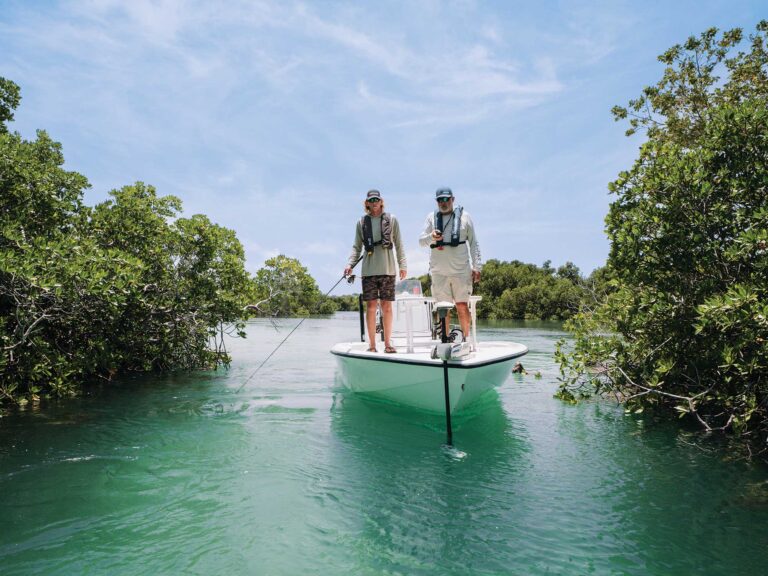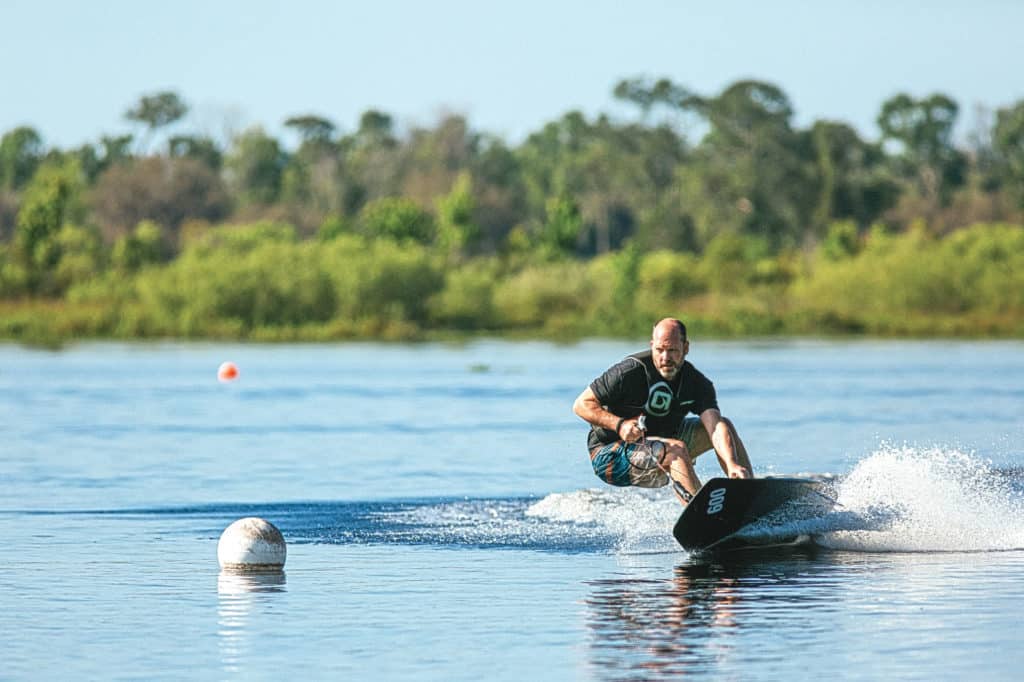
Anybody remember their dorm-room decor? Though I went to school just outside of Philadelphia, mine was filled with surf posters, palm trees and, yeah, probably the occasional bikini poster. Blame the Beach Boys. When temps were cold and skies were gray, they’re the ones who had me singing along to songs of sunshine and endless waves. The former I found by moving to Florida after graduation. The latter, however, I only discovered recently, compliments of an open body of water—and the JetSurf motorized surfboard.
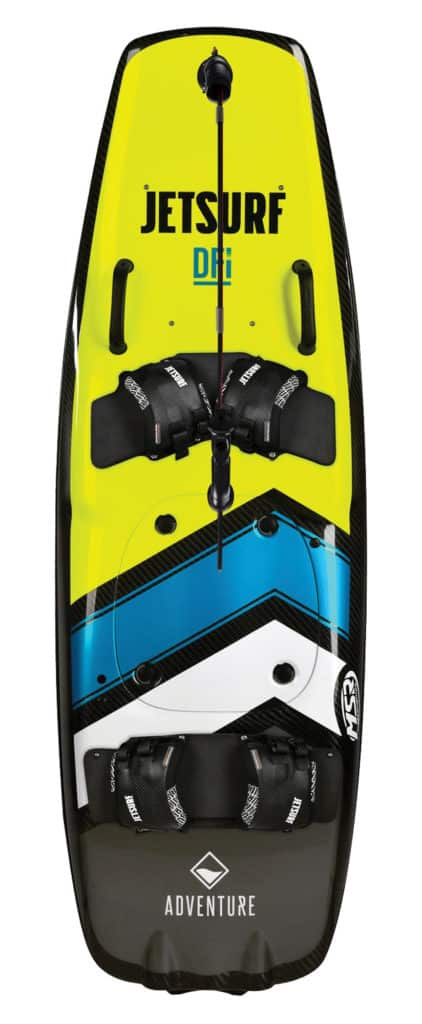
JetSurf Adventure DFI
Wakesurfing may deliver more of a true surfing feel, but if you’re looking for an endless wave, then jet surfing just may be your ticket to paradise. JetSurf’s Adventure DFI ($11,400) resembles a chunky wakeboard but features a compact 100 cc NG 100 DFI two-stroke within its 71-by-24-by-6-inch profile. Its pint-size 0.74-gallon fuel tank may not exactly promise the endless wave, but it is good for about an hour of cruising time. The equally compact single-stage, axial-flow jet pump and impeller are, like the board itself, fabricated from carbon fiber. Total weight? A relatively modest 44 pounds. A lithium-ion battery promises about 150 starts—or three hours of continuous riding—and recharges in 45 minutes via a 12-volt plug.
For beginners, getting up is kind of a mix between a stand-up personal watercraft and a surfboard, with momentum the key to balance. Smoothly throttle up and the board planes and stabilizes, allowing you to rise from a kneeling position to your feet. Keep that momentum and you’re good to go; wobble and release the throttle, and the abrupt slowdown may put you in the drink.
A light hand on the pistol-grip throttle—attached by cable to the nose of the board—and smooth acceleration are key to control. Although the JetSurf felt quite stable in a straight line, turns were initially more challenging to master. Unlike most board sports, heel-to-toe edging doesn’t immediately cause the board to respond. Experienced riders suggest abandoning all-out balance and edge control in favor of using the control handle and cable as a kind of fixed towrope to lean against. In this posture, riders can almost pull the nose into a turn, as well as relax more atop the board. Speed peaks at 35 mph, but we suggest keeping those first rides slower, around 15 to 18 mph, until you get a feel for the board and how it will respond, particularly in the tight turns.
Sound cool? Here are four other alternative water toys to try. But first, cue that summer playlist.
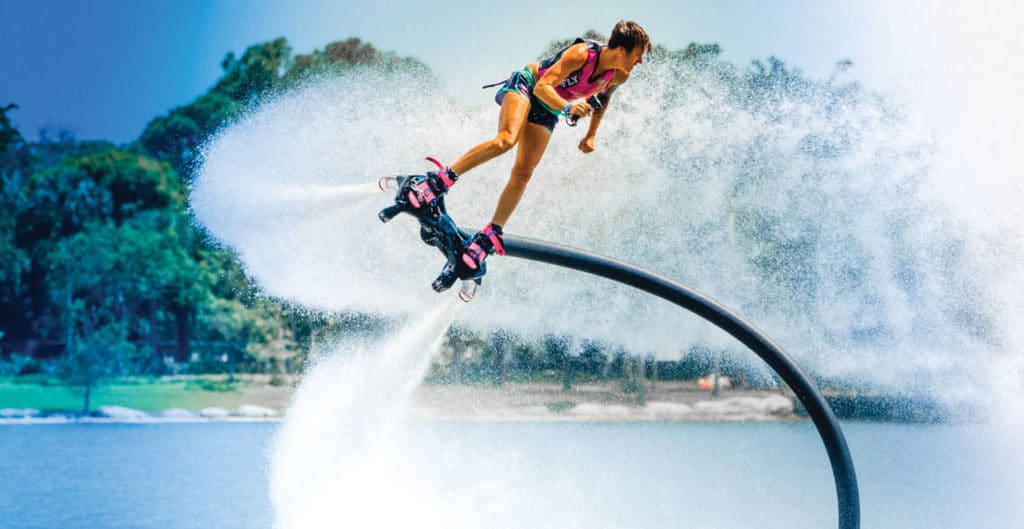
Zapata Flyboard
Let be known: Iron Man is my favorite Avenger, and he’s probably right up there with you too. And you can make like everyone’s favorite genius Avenger and fly through the air with powerful jets below your feet. All you need is the Flyboard—and a little borrowed thrust from a nearby personal watercraft.
For a gadget that creates such jaw-dropping action, the Flyboard’s mechanics are surprisingly simple. Start with the air-time-providing thrust of not air, but water. It’s harnessed by swapping out a PWC’s thrust nozzle for a U-shaped adapter pipe that diverts the pressurized water into a 60- to 75-foot hose. From there it flows to the hydroflyer, a skateboard-size deck with wakeboard-style bindings above and twin jet nozzles below. Give the PWC the gas and that thrust creates air time, allowing flyers to soar above the water in a horizontal, standing position. Bearings at the hose-board connection ensure the board can swivel without worries of entanglement.
In the learning stages, flying is a two-person job. Base models lack a designated throttle, meaning a second person is required to be on the PWC to control and vary the thrust. Ideally that second person joins you in the learning stages at one of Flyboard’s many rental locations scattered about the world. It’s here that a certified Flyboard instructor will carefully control that throttle to dramatically shorten the learning curve—not to mention avoid a wiseguy buddy giving you an unexpected goose of elevation when least expected. Experienced riders will ultimately want to take control into their own hands via Zapata’s wireless Electronic Management Kit, a handheld trigger-style controller that communicates directly with the PWC to give total control to the flyer. Steering body and board through the air is a combination of well-timed thrust, and weight and balance shifts familiar to board-sport enthusiasts. Feet can also individually pivot from heel to toe, increasing maneuverability. With practice, experienced flyers can perform spins, loops, and even dive dolphin-style below the surface before soaring once again skyward.
Price: Starting at $4,370 (minimum 100 hp PWC not included); flyboard.com
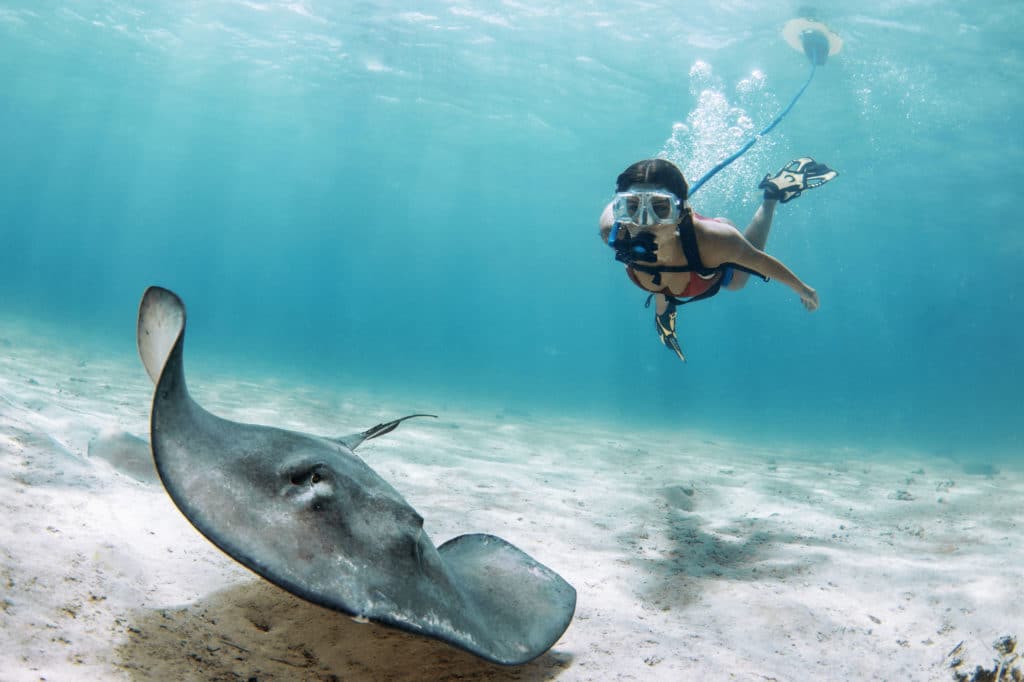
BLU3 Nemo Dive System
The Nemo Dive System is one of those Kickstarter success stories, securing its full funding only 36 hours after popping up online. You can think of it as snorkeling on steroids, a device that allows you to go up to 10 feet below the surface and breathe for up to 60 minutes on a single battery charge. Throw it in the boat, and you and your guests are ready to explore that favorite sandbar, reef or shallow-water wreck. It’s also handy for in-water maintenance dockside, or even pool maintenance at home.
The Nemo system consists of three primary parts: a compressor that floats atop the surface, a swappable battery pack and, at the end of the 10-foot air hose, a “smart” regulator. It works hand in hand with the compressor to not just pump nonstop air, but actually match the pressure, volume and flow rate the diver needs at any given depth. The key is an internal silicone diaphragm that moves every time the diver breathes. A sensor measures that movement, sends a signal to the compressor, and air is pumped at the exact time and speed the diver is inhaling. In that sense the compressor doesn’t just push air to the diver but, as Nemo says, actually “breathes with you.” This approach allows the Nemo to use a reported one-tenth of the power needed by other underwater breathing systems. As such it requires only a 14.8-volt li-ion battery to provide about an hour of air time, and fully recharges in just three hours.
At 11 inches by 7.5 inches by 8 inches, the 10-pound Nemo can be easily carried in a backpack and stashed in an onboard storage compartment. Worried about the reality of a Kickstarter product? BLU3 is a subsidiary of Brownie’s Marine Group, already a leading developer, manufacturer and distributor of specialized dive and safety products.
Price: $450; browniesmarinegroup.com
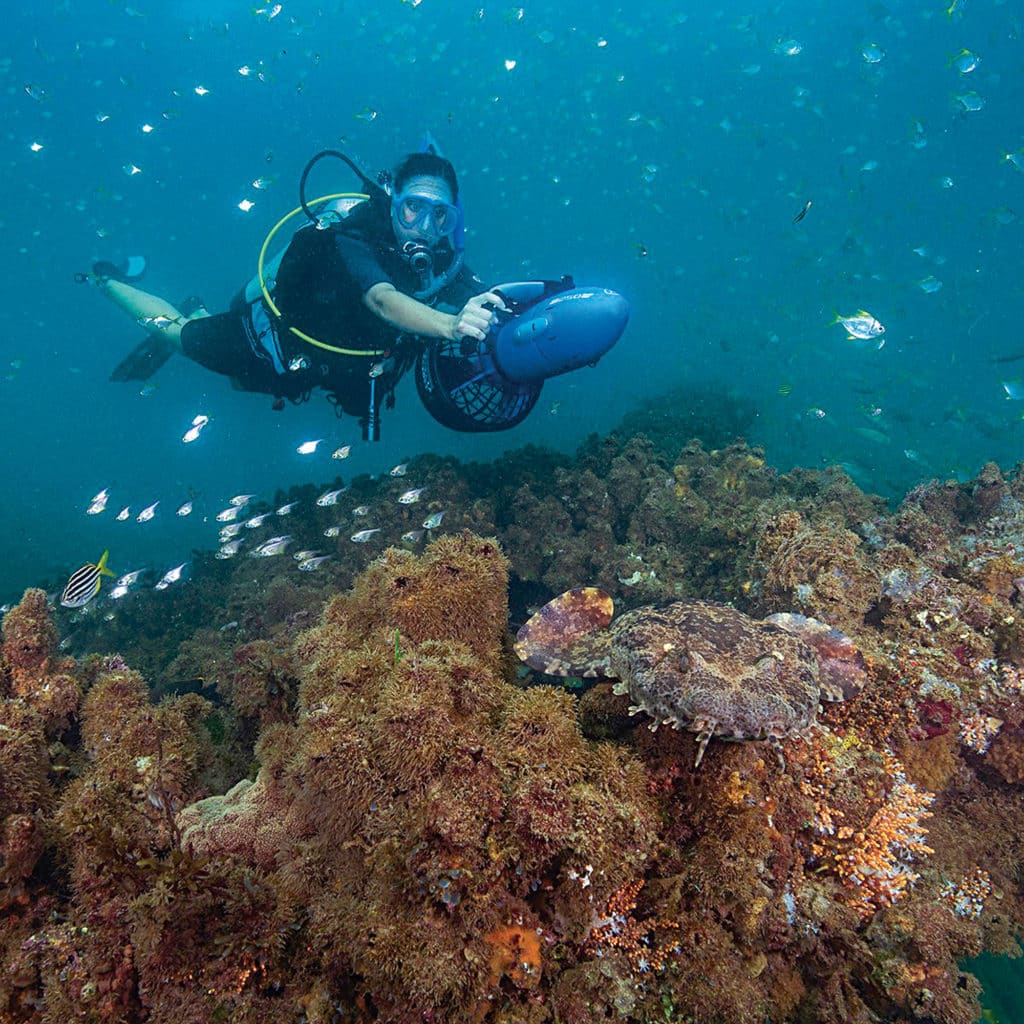
Yamaha RDS250 Underwater Seascooter
Remember those cool underwater chases in the 1965 James Bond film Thunderball? That’s how it feels to be pulled along by Yamaha’s RDS250 Seascooter, a bright-blue torpedo that puts flipper propulsion to shame and keeps users from running out of steam during extended dives.
Like Bond’s old-school equipment, the RDS250 features a bullet-shaped nose and enclosed propeller aft, but the modern finished product is cutting-edge cool. Twin pistol-style handgrips offer a secure handhold. Dual triggers, one on each handgrip, are squeezed to apply the power; the propeller stops if either is released. Should you want to film your own Thunderball scene, a GoPro mount is included just forward of the handlebar. Capture POV footage facing forward, or spin it around and see yourself leaving those imaginary SPECTRE baddies in your wake. A top speed of 2.5 mph may sound slow on land, but underwater it feels surprisingly quick as you glide effortlessly forward, controlling direction with an appropriate twist or angle of your arms.
A sealed, lead-acid battery is accessed by removing the nose cone. Charge lasts about two hours with continuous use; the battery fully recharges in about six to eight. Below the O-ring- sealed nose cone is also where you’ll find the buoyancy control chamber, which can be adjusted to provide neutral or positive buoyancy depending on user or dive conditions. Total weight is 18 pounds. Coupled with the unit’s 24-by-15.2-by-12.3-inch dimensions, the combination makes it easy to carry the Seascooter aboard as well as stow in an onboard compartment.
An interesting side note? There are a surprising number of sea scooters on the market, many of which are licensed by personal-watercraft manufacturers Yamaha and Sea-Doo. Prices vary significantly, from $150 entry-level models targeted toward kids to professional dive models costing close to $2,000.
Price: Starting at $150; yamahaseascooters.com
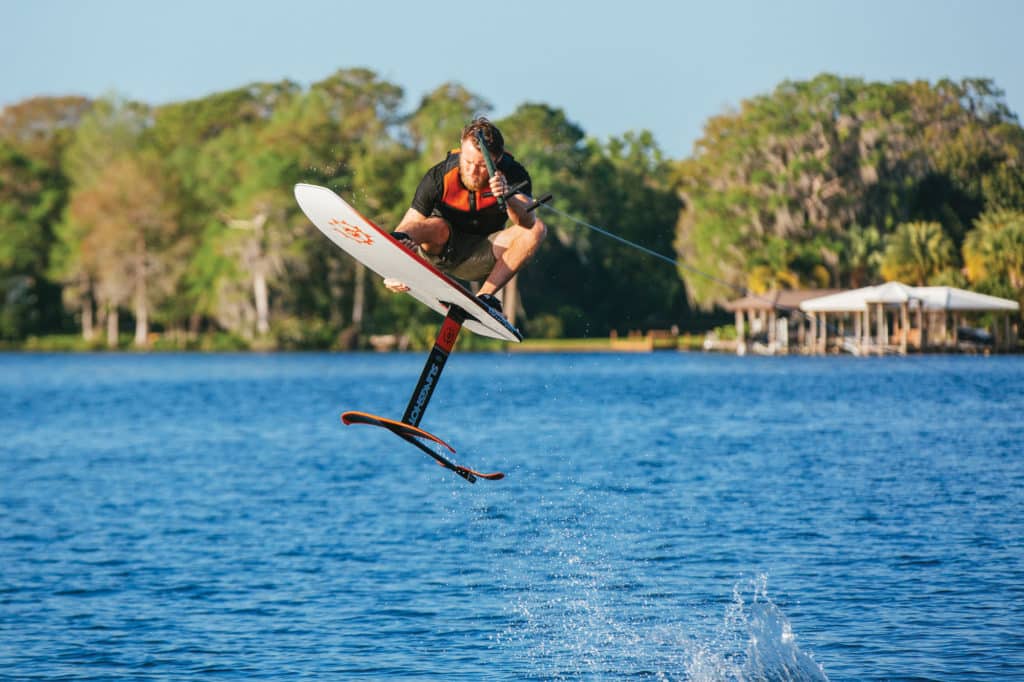
Slingshot Hover Glide Wake Foil
Hydrofoils are no stranger to watersports. The foil-equipped Air Chair hit the market in 1990 but never spiked mainstream curiosity, possibly because a seated position isn’t how most people envision board sports. Foils like Slingshot’s Hover Glide Wake Foil promise to finally entice the masses to get off the surface—and start flying.
The Wake Foil is essentially a wakesurf board with hydrofoil hardware mounted to the bottom. A vertical mast determines just how high your board will fly above the water. A leading blade, or wing, determines just how much lift the board will have, how fast it will ride, and how responsive the board will feel in the water.
Riding the Wake Foil is a unique experience. Start and stance share much in common with wakeboarding or wakesurfing, but once you’re riding above the water on the foil, you get the sensation of flying—or the floaty feeling that snowboarders love on a powder day. Riding above the water on the foil also pays practical dividends. Water conditions no longer matter, enabling riders to still enjoy the activity when its rough and choppy.
Beginners start on the shortest, 15-inch mast. Experienced riders wanting added height can graduate to masts up to 24 inches in length. A full-length towrope is recommended to get you away from any prop or jet wash provided by your tow vehicle. After some acclimation time riding the board on the water’s surface (keep your weight forward on the front foot to prevent takeoff), riders elevate the board by subtly shifting their weight from the front to back foot, or their stance toward the tail, causing the wing to ride upward toward the surface. Once flying, holding a consistent elevation is similar to using a balance board; again, subtle movements change the height of the wing underwater. Carving back and forth is similar to the toe-to-heel edging common with most board sports.
Read Next: Six Top Tow Tubes
Hydrofoils don’t require a large wake nor a powerful boat. Speeds up to 15 mph are more than adequate, meaning anything from a MasterCraft to a WaveRunner fits the bill.
Price: Starting at $1,776; slingshotsports.com








